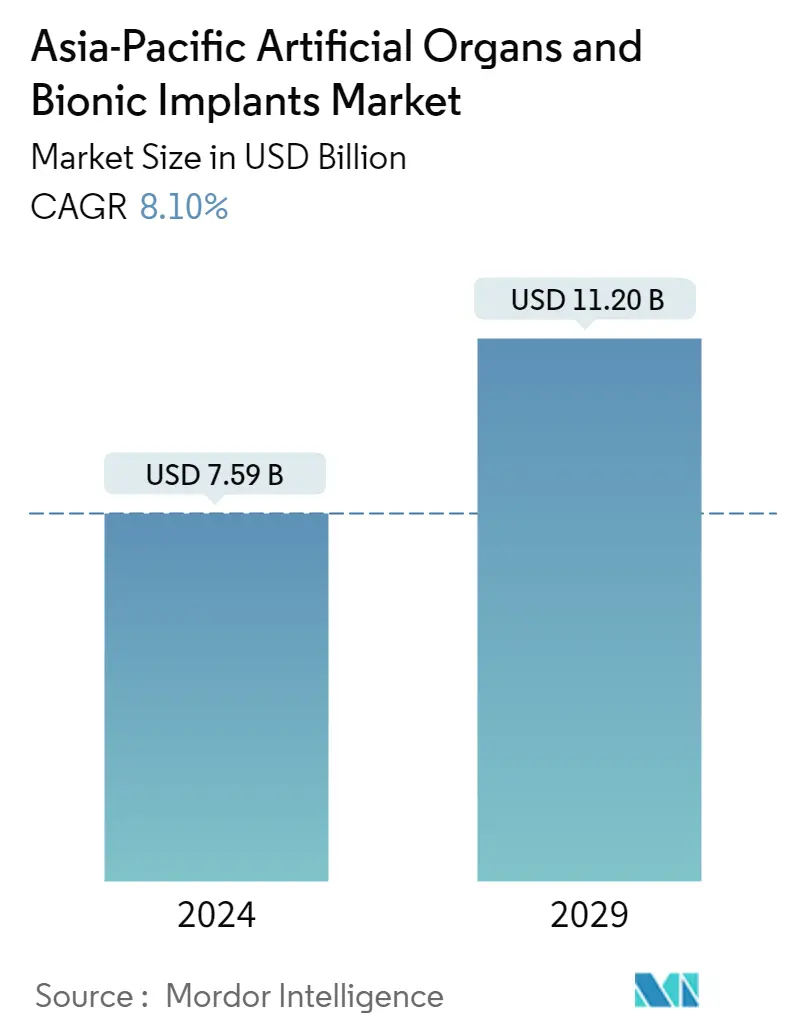Market Size of Asia-Pacific Artificial Organs and Bionic Implants Industry

| Study Period | 2021 - 2029 |
| Base Year For Estimation | 2023 |
| Market Size (2024) | USD 7.59 Billion |
| Market Size (2029) | USD 11.20 Billion |
| CAGR (2024 - 2029) | 8.10 % |
| Market Concentration | Low |
Major Players
*Disclaimer: Major Players sorted in no particular order |
Need a report that reflects how COVID-19 has impacted this market and its growth?
APAC Artificial Organs & Bionic Implants Market Analysis
The Asia-Pacific Artificial Organs and Bionic Implants Market size is estimated at USD 7.59 billion in 2024, and is expected to reach USD 11.20 billion by 2029, growing at a CAGR of 8.10% during the forecast period (2024-2029).
The impact of COVID-19 was severe on the studied market owing to the cancellations of elective procedures, including implants of artificial organs, in the Asia Pacific region. However, the market started to gain traction in the last year as transplants and implant procedures resumed in the region. Also, the piling up of elective procedures involving artificial organs and bionics is projected to augment the market during the forecast period.
In addition, the increased incidence of disabilities, the rising number of road accidents, and technological advancements in products leading to enhanced applications are positively affecting the growth of the studied market.
As the number of disabled people grows, so does the demand for bionic implants, which are prosthetics with both mechanical and robotic elements that replace broken body parts such as hands, legs, limbs, and so on.
As per the Road Accidents in India report, the number of traffic accidents in the country has increased from 3,68,828 in 2020 to 4,22,659 in 2021. The region's high rate of road accidents, as well as rising injury and trauma, is driving market growth.Furthermore, the growing geriatric population, which is more prone to organ failure, is expected to drive growth during the forecast period.According to the United Nations ESCAP, the Asia-Pacific population is aging faster than any other region in the world. In the current year, there are 630 million people aged 60 and up, accounting for 60% of the world's elderly.By 2050, their number is projected to increase to 1.3 billion. The increase in the trend of the population will help boost the overall market growth.
Various groups of national universities, hospitals, and companies are engaged in a collaborative research and development program to develop artificial organs, which is also funded by the government authorities and the businesses. For example, as part of the Australian federal government's budget announcement in May 2021, Monash University researchers secured Medical Research Future Fund (MRFF) research funding in areas such as maternal health, rare cancers and diseases, silicosis, and nutrition and well-being in remote communities, with the Artificial Heart Frontiers Program receiving USD 999,570 in 2021 for the development of artificial hearts.BiVACOR is also funding and collaborating on the initiative to develop and market a total artificial heart.Such partnerships and research developments are anticipated to boost market growth during the forecast period.
Therefore, owing to the aforementioned factors, it is anticipated that the studied market will witness growth over the analysis period. However, the expensive procedures and fear of device malfunction and its consequences are likely to impede market growth.
